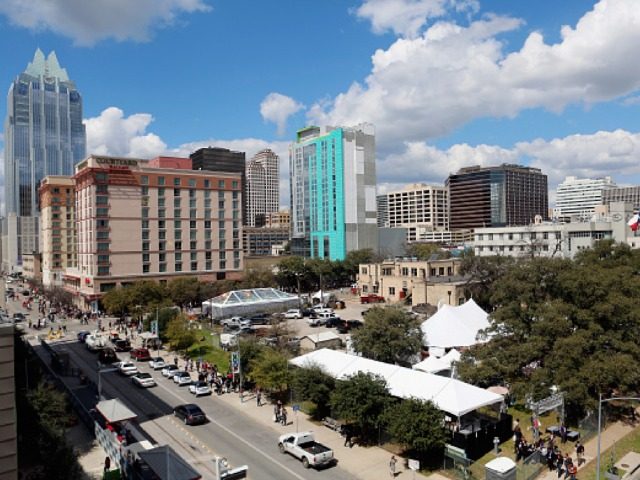New projections from the American City Business Journals (ACBJ) ranked five Texas metropolitan areas among the fastest growing Top 10 U.S. cities. By 2040, they expect to see explosive population growth.
ACBJ, the parent company of the Dallas Business Journal, generated these statistics for 933 metro and micropolitan regions based on data from the U.S. Census Bureau and the University of Virginia’s Weldon Cooper Center for Public Service.
Of those Texas cities on the Top 10 list of America’s fastest growing metros, Austin came in first place. ACBJ foresees the Austin-Round Rock area to nearly double its population from two million to four million in the next 24 years. This reflects a 98.5 percent increase in residents. Although Austin is poised to become the fastest growing U.S. city, it is not the largest. Following Austin on the list were Houston-The Woodlands-Sugar Land (5), San Antonio-New Braunfels (6), Dallas-Fort Worth-Arlington (7), and McAllen-Edinburg-Mission (10).
Two of the Top 10 fastest growing cities in the country were in Florida — Cape Coral-Fort Meyers (2) and Orlando-Kissimmee-Sanford (4). Raleigh, NC (3), Charleston-North Charleston, SC (8), and Denver-Aurora-Lakewood, CO (9) also made the list.
Within Texas, Houston just may overtake Dallas as the state’s largest metropolis in 2040. Currently, 7.1 million people reside in Dallas-Fort Worth-Arlington (DFW). The Dallas Business Journal reported DFW could swell to 10.9 million people, a 53.5 percent population increase. However, the Houston-The Woodlands-Sugar Land population should balloon to 11.1 million, up 66.7 percent from its current 6.6 million.
In March, the U.S. Census Bureau released figures tracking the Texas population boom fueled by nearly half a million people relocating to the Lone Star State over the one year period of July 2014 to July 2015. That is more than any other state in the nation. Statistical growth patterns in that report, lead by Houston-The Woodlands-Sugar Land and closely followed by DFW, mirror ACBJ’s projections.
According to ACBJ, smaller Texas cities like McAllen-Edinburg-Mission may see its population jump 51.3 percent by 2040. The area’s roughly 842,000 population could soar to 1.275 million. El Paso should experience a 17.5 percent uptick from 839,000 to 985,476 residents. Midland could have a 75 percent growth spurt, jumping from today’s 167,000 residents to nearly 300,000. Odessa is poised for 67.4 percent growth. Its population will grow from around 159,400 to 266,860.
Nationally, ACBJ expects New York City to remain the most populated large metro area in 2040, even though Los Angeles grows at a faster pace. The Big Apple will have 22.5 million city dwellers while Tinseltown, in second place, may only reach 15 million. Houston and Dallas will take the third and fourth spots, respectively. Chicago, with 9.7 million residents today, will likely drop to fifth place. ACBJ also anticipates Philadelphia, currently seventh, will sink to 11th place by 2040. Phoenix, and California’s San Francisco-Oakland and Riverside-San Bernardino will surpass Boston, now in 10th place and expected to drop to 13th.
Demographers called Myrtle Beach, SC, the hottest growth prospect in smaller cities with 500,000-999,999 residents in 2040. They estimate the city will expand by over 85 percent to a population of 800,000.
Earlier in October, WalletHub named DFW suburb Frisco the nation’s fastest growing mid-size U.S. city with 154,407 residents. The upscale sprawling urban community is home to the Dallas Cowboys corporate headquarters and state-of-the-art practice facility called the Star, an estimated $1.5 billion venue on a 91-acre compound that boasts two outdoor practice fields, underground parking, plans for an Omni hotel hotel, retail, and a Baylor, Scott & White sports therapy research center. It opened in late August. California companies like Jamba Juice and Toyota transplanted their headquarters to Frisco. The Japanese automaker’s massive 100-acre campus expects to be operational mid-2017. In May, Breitbart Texas reported Frisco was one of five Texas midsize cities to rank on the nation’s fastest growing between 2014-15.
Last year, Breitbart Texas reported on a study released by the Office of the State Demographer. It predicted if migration patterns continued on the same pace as in 2000 to 2010, Texas would see explosive population growth – up to 54.4 million people, based on immigration and migration patterns as people continue to pour in from other U.S. states.
Follow Merrill Hope, a member of the original Breitbart Texas team, on Twitter.

COMMENTS
Please let us know if you're having issues with commenting.